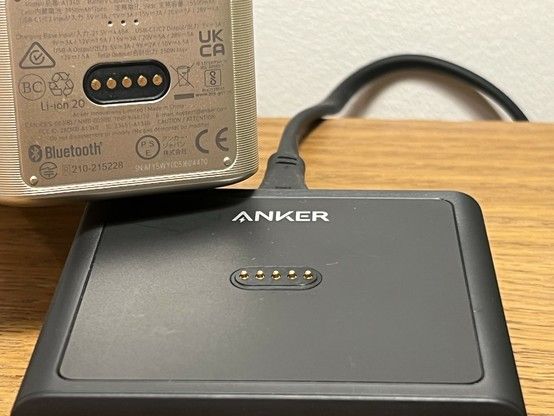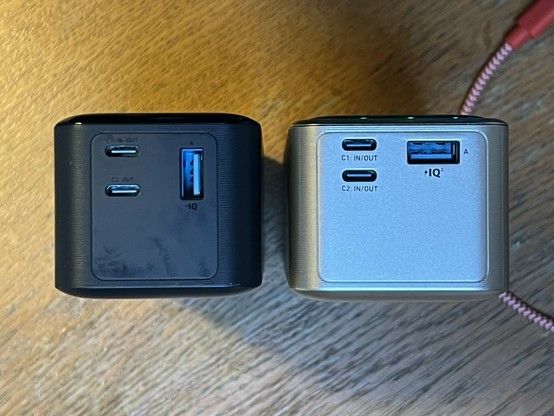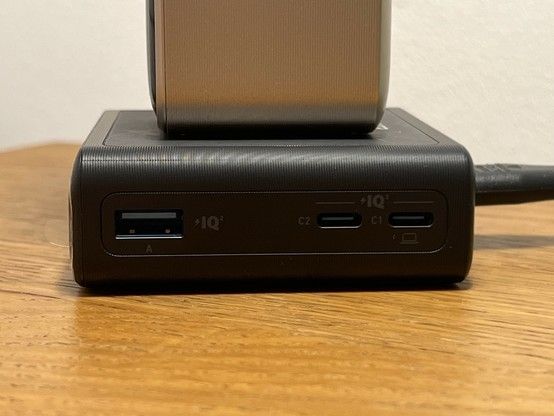Anker Prime 27,650mAh 250W Power Bank Review
A long time ago in a blog post fa… well on this very same blog… I reviewed the Anker PowerCore 10K Wireless. While testing this battery I got distracted by a thought- what if the battery had a grab and go charging cradle?
The gold battery on the black charger kinda works okay… it has alignment magnets too, nice.
Fast forward almost four years and Anker finally got the memo- the shiny new Prime portable batteries include a five pin docking connector, providing a reversible connection for standing a battery on top of a charging cradle. Regrettably Anker, being Anker, might have over engineered the cradle slightly and made it a bit pricy for the extra convenience, but it does also make a great laptop power supply or means of charging a couple of extra devices.
The battery has a five pin reversible charging connection to the (optional and very expensive) charging base. It’s actually a really nice bedside setup but you’re definitely going to want to wait on sale prices 🤣
That said if you’ve got multiple batteries it would make a great tech charging hub in a kitchen or hallway.
I convinced Anker to send me a Prime 27,650mAh, 250W battery and forked out the £49 sale price to pick up the 100W Anker Charging Base. It’s gone back up to £69.99 since, though there’s a 20% discount to soften the blow. Maybe a bit pricy was an understatement.
The battery itself – which features two USB Type-C ports and a USB Type-A, an status display and Bluetooth connectivity (which is less useless than it sounds) – comes in at £179.99. Also with 20% off at time of writing. Suffice to say it’s a little pricier than UGREEN’s Nexode but you’ll be surprised how useful a detailed status display can be on a portable battery, Anker definitely bring the features to match the price.
The ports have received a little refinement, and yes those USB Type-C ports being perhaps uncomfortably close is probably another side-effect of squeezing an extra cell in there. I’ll take the rotated USB A port, though, it kinda makes sense.
Like the Anker 737 “PowerCore 24k” I tested back in November 2022 (sheesh, time flies) the 27k Prime battery is a hulking, hefty brick. It weighs in at 658g (according to my kitchen scale) which is very close to the 627g of its older sibling. It’s roughly the same width and depth, but stands a noticable centimeter taller. I ended up testing the gold version (I guess it’s what was available) and actually prefer it over the black for the better colour contrast of the port labels. I complained about the In/Out and C1/C2 labels on the original 24K being very difficult to see- a common theme on batteries and wall adapters trying to look slick- and it looks like this is fixed on both the black and gold 27K batteries.
Similarly the usual regulatory waffle has moved from the back of the battery – where it’s virtually impossible to read – to the bottom. This is useful since I can squint at this text and tell you that the actual cells have changed from 6x4000mAh to 7x3950mAh. It’s notable from the side view – where the button is – that the 27K’s button has moved toward the front to accommodate that seventh cell.
I’m not going to cut it open to find out, but I’m guessing the function button being moved slightly toward the front of the new Prime 27K battery (I insist on calling it that) is how they’re accommodating a 7th cell over the six of the PowerCore 24K.
The 27K pinches most of its features from the older 24K but includes some notable refinements. The taller battery is also styled such that the extra height is a design detail- a little extra gold over the shiny black front- which evokes that “20% extra free” style design you get on packets of Pringles. The whole front of the battery being a seamless, gloss plastic is probably the biggest departure from the 24K. It conceals the display really effectively and looks slick.
Rather than split functions between USB-C ports, the new 27K battery can charge from either and will provide power from either. This is a minor but appreciated upgrade since plugging in to charge in a hurry no longer means playing the which-port-actually-charges-this lottery. With both ports now being capable of charging the battery itself you can use two USB Type-C cables simultaneously to hit up to 170W recharging speed. That’s quite silly, and you’re really going to have to be in a hurry. But it’s another nice to have.
The USB Type-A port has seen a bump from Anker’s proprietary PowerIQ 1.0 to PowerIQ 2.0, which includes support for QC 3.0. If none of these specs make any sense to you (they don’t for me, either) then in real terms this means a bump from 12W to 18W max. At least according to the specifications. Since anything I have needing that much juice has long since switched over to Type-C.
There’s really no contest between the displays. The bigger, brighter display of the new 27K plays host to some useful new features, too, such as remaining charges for configured phones (set up via the app and Bluetooth connection.)
The display – taking advantage of the redesigned, seamless front – is bigger, brighter and better. Tap the side button a couple of times and you’ll be greeted with a status screen showing battery health, temperature and – if you’ve set up your devices via Bluetooth – a list of your phones/laptops/devices complete with the number of times they can be fully recharged at the battery’s current charge level. My iPhone 13 Pro will apparently get six and a half full charges, while a larger iPhone 15 Pro Max gets just shy of four.
With both power banks on their respective “status” displays (accessed by pressing the side button a few times) it’s clear how much bigger and more useful the new 27K display is. Rather than fill space with nonsense facts like “3024 screen uses” it includes a tabulated list of configured phones and the number of times they can be recharged. Essential info such as temperature and health is still available, though we’ve lost battery cycles.
Pairing the Prime 27K (I’m going to call it that, because their name is awkward) to your phone via Bluetooth, and using the Anker app will give you realtime charge information and – crucially – the ability to save multiple devices to the battery so you can get an at-a-glance look at how many charges your phone or Nintendo Switch has left. Bluetooth also means you can apply firmware updates to your battery- I’ve done at least one during my tests, but I’ve no idea what it actually did.
From the app you can also pick between a basic and slightly more advanced device status screen- the more advanced version will show the voltage and current that the connected device is being charged at. There are a handful of other settings – some useful, some debatable – but overall the app is actually pretty decent for something I’ve forgive you for decrying as silly and pointless. Perhaps my favourite feature is the graphs which give a detailed look into the output voltage and current of a device over time. I always reached for my PowerCore 24K when I wanted a little insight into what power supplies would deliver, or devices would consume. The 27K gives this same information but takes the effort out of checking periodically and sticking it into a graph. I still want a ChargerLAB KM003C though… Sadly the Prime 27K does not scale the graphs to make inspecting low-voltage or low-current charge cycles easy, and if you want to export that juicy data for analysis good times then sorry, no dice. It’s good as a quick is-my-device-charging-properly debug tool, but sadly falls short of being truly useful.
The aforementioned charging base – a £69.99 extra – works well as a standalone bedside charging hub- with two USB Type-C ports and a single Type-A it mirrors the power bank. At 100W is slightly beats The charging base at least justifies its cost with two USB Type-C ports and one Type-A. Its hefty enough to stay planted on a bedside table even without the half kilo and change of battery on top. It’s still very useful, though, and its hefty enough to stay planted on a bedside table even without a power bank being charged on top. Thinking of it as a dedicated charger with bonus ports might help if it were cheaper- and indeed the £49.99 I managed to snag it for is a lot less of a sting- but Anker could have gone with two products here. A cheap, simple USB-C pass-through base to use with an existing power supply, and a beefier version of the full charging base. Sheesh I bet some smart design could have merged a Qi (wireless) charger and five pin connector into the same base. The gold battery on the black charger kinda works okay… it has alignment magnets too, nice. Overall the Prime 27K – or “Anker Prime 27,650mAh Power Bank (250W)” as Anker would have you call it – is an evolutionary upgrade of its PowerCore 24K sibling. Pretty much everything has been improved – from more power, a bigger brighter display, more fully featured ports, better port status reporting and more visible labels – and the £179.99 price isn’t far off the £140 I remarked on at the time. Almost dead on if you use that 20% off! When I imagined a charging base for Anker batteries I didn’t imagine it being quite so pricy- and now I’ve got another thought. I wonder how that charging connector works and whether it’s possible to build a tiny, inexpensive, dedicated charging stand. I also wonder why Anker didn’t just use Qi wireless charging- a slow overnight trickle charge would be fine, considering the power bank can be boosted quickly with two cables and a beefy enough wall adapter. At time of writing I still regularly use the PowerCore 24K, a year and a half or so of use has taken the battery health down to 98% and recorded 67 charge cycles with almost 6,000wh of power in and out. It’s got more than a few scuffs and scratches from being chucked in bags and toted around. I imagine it’ll continue to serve me for many more years. You can pick up the Anker Prime 27,650mAh Power Bank (250W) (please can we call it the Anker Prime 27K?) and the 100W Power Bank Charging Station direct from Anker. Both the battery and base have separate 20% off discount codes, but you can use them together. You might notice that the above links are not tracked or affiliate links. I don’t want perverse incentives biasing my opinions. Anker do not pay me for these reviews, but they did supply the power bank (I purchased the charging base.) If you appreciate this, please throw me a few bucks via ko-fi.com/gadgetoid, patreon.com/gadgetoid or even github.com/sponsors/gadgetoid.Support Gadgetoid






